标签:
一、前言
分析完了CyclicBarrier后,下面分析CountDownLatch,CountDownLatch用于同步一个或多个任务,强制他们等待由其他任务执行的一组操作完成。CountDownLatch典型的用法是将一个程序分为n个互相独立的可解决任务,并创建值为n的CountDownLatch。当每一个任务完成时,都会在这个锁存器上调用countDown,等待问题被解决的任务调用这个锁存器的await,将他们自己拦住,直至锁存器计数结束。下面开始分析源码。
二、CountDownLatch数据结构
从源码可知,其底层是由AQS提供支持,所以其数据结构可以参考AQS的数据结构,而AQS的数据结构核心就是两个虚拟队列:同步队列sync queue 和条件队列condition queue,不同的条件会有不同的条件队列。读者可以参考之前介绍的AQS。
三、CountDownLatch源码分析
3.1 类的继承关系
public class CountDownLatch {}
说明:可以看到CountDownLatch没有显示继承哪个父类或者实现哪个父接口,根据Java语言规定,可知其父类是Object。
3.2 类的内部类
CountDownLatch类存在一个内部类Sync,继承自AbstractQueuedSynchronizer,其源代码如下。

private static final class Sync extends AbstractQueuedSynchronizer { // 版本号 private static final long serialVersionUID = 4982264981922014374L; // 构造器 Sync(int count) { setState(count); } // 返回当前计数 int getCount() { return getState(); } // 试图在共享模式下获取对象状态 protected int tryAcquireShared(int acquires) { return (getState() == 0) ? 1 : -1; } // 试图设置状态来反映共享模式下的一个释放 protected boolean tryReleaseShared(int releases) { // Decrement count; signal when transition to zero // 无限循环 for (;;) { // 获取状态 int c = getState(); if (c == 0) // 没有被线程占有 return false; // 下一个状态 int nextc = c-1; if (compareAndSetState(c, nextc)) // 比较并且设置成功 return nextc == 0; } } }
说明:对CountDownLatch方法的调用会转发到对Sync或AQS的方法的调用,所以,AQS对CountDownLatch提供支持。
3.3 类的属性
public class CountDownLatch { // 同步队列 private final Sync sync; }
说明:可以看到CountDownLatch类的内部只有一个Sync类型的属性,这个属性相当重要,后面会进行分析。
3.4 类的构造函数
1. CountDownLatch(int) 型构造函数

public CountDownLatch(int count) { if (count < 0) throw new IllegalArgumentException("count < 0"); // 初始化状态数 this.sync = new Sync(count); }
说明:该构造函数可以构造一个用给定计数初始化的CountDownLatch,并且构造函数内完成了sync的初始化,并设置了状态数。
3.5 核心函数分析
1. await函数
此函数将会使当前线程在锁存器倒计数至零之前一直等待,除非线程被中断。其源码如下

public void await() throws InterruptedException { // 转发到sync对象上 sync.acquireSharedInterruptibly(1); }
说明:由源码可知,对CountDownLatch对象的await的调用会转发为对Sync的acquireSharedInterruptibly(从AQS继承的方法)方法的调用,acquireSharedInterruptibly源码如下

public final void acquireSharedInterruptibly(int arg) throws InterruptedException { if (Thread.interrupted()) throw new InterruptedException(); if (tryAcquireShared(arg) < 0) doAcquireSharedInterruptibly(arg); }
说明:从源码中可知,acquireSharedInterruptibly又调用了CountDownLatch的内部类Sync的tryAcquireShared和AQS的doAcquireSharedInterruptibly函数。tryAcquireShared函数的源码如下

protected int tryAcquireShared(int acquires) { return (getState() == 0) ? 1 : -1; }
说明:该函数只是简单的判断AQS的state是否为0,为0则返回1,不为0则返回-1。doAcquireSharedInterruptibly函数的源码如下

private void doAcquireSharedInterruptibly(int arg) throws InterruptedException { // 添加节点至等待队列 final Node node = addWaiter(Node.SHARED); boolean failed = true; try { for (;;) { // 无限循环 // 获取node的前驱节点 final Node p = node.predecessor(); if (p == head) { // 前驱节点为头结点 // 试图在共享模式下获取对象状态 int r = tryAcquireShared(arg); if (r >= 0) { // 获取成功 // 设置头结点并进行繁殖 setHeadAndPropagate(node, r); // 设置节点next域 p.next = null; // help GC failed = false; return; } } if (shouldParkAfterFailedAcquire(p, node) && parkAndCheckInterrupt()) // 在获取失败后是否需要禁止线程并且进行中断检查 // 抛出异常 throw new InterruptedException(); } } finally { if (failed) cancelAcquire(node); } }
说明:在AQS的doAcquireSharedInterruptibly中可能会再次调用CountDownLatch的内部类Sync的tryAcquireShared方法和AQS的setHeadAndPropagate方法。setHeadAndPropagate方法源码如下。

private void setHeadAndPropagate(Node node, int propagate) { // 获取头结点 Node h = head; // Record old head for check below // 设置头结点 setHead(node); /* * Try to signal next queued node if: * Propagation was indicated by caller, * or was recorded (as h.waitStatus either before * or after setHead) by a previous operation * (note: this uses sign-check of waitStatus because * PROPAGATE status may transition to SIGNAL.) * and * The next node is waiting in shared mode, * or we don‘t know, because it appears null * * The conservatism in both of these checks may cause * unnecessary wake-ups, but only when there are multiple * racing acquires/releases, so most need signals now or soon * anyway. */ // 进行判断 if (propagate > 0 || h == null || h.waitStatus < 0 || (h = head) == null || h.waitStatus < 0) { // 获取节点的后继 Node s = node.next; if (s == null || s.isShared()) // 后继为空或者为共享模式 // 以共享模式进行释放 doReleaseShared(); } }
说明:该方法设置头结点并且释放头结点后面的满足条件的结点,该方法中可能会调用到AQS的doReleaseShared方法,其源码如下。

private void doReleaseShared() { /* * Ensure that a release propagates, even if there are other * in-progress acquires/releases. This proceeds in the usual * way of trying to unparkSuccessor of head if it needs * signal. But if it does not, status is set to PROPAGATE to * ensure that upon release, propagation continues. * Additionally, we must loop in case a new node is added * while we are doing this. Also, unlike other uses of * unparkSuccessor, we need to know if CAS to reset status * fails, if so rechecking. */ // 无限循环 for (;;) { // 保存头结点 Node h = head; if (h != null && h != tail) { // 头结点不为空并且头结点不为尾结点 // 获取头结点的等待状态 int ws = h.waitStatus; if (ws == Node.SIGNAL) { // 状态为SIGNAL if (!compareAndSetWaitStatus(h, Node.SIGNAL, 0)) // 不成功就继续 continue; // loop to recheck cases // 释放后继结点 unparkSuccessor(h); } else if (ws == 0 && !compareAndSetWaitStatus(h, 0, Node.PROPAGATE)) // 状态为0并且不成功,继续 continue; // loop on failed CAS } if (h == head) // 若头结点改变,继续循环 break; } }
说明:该方法在共享模式下释放,具体的流程再之后会通过一个示例给出。
所以,对CountDownLatch的await调用大致会有如下的调用链。
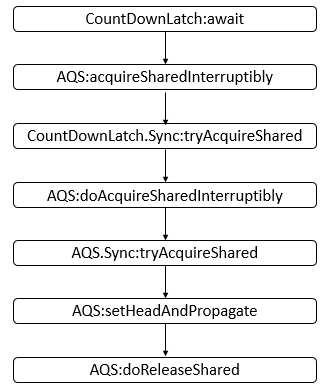
说明:上图给出了可能会调用到的主要方法,并非一定会调用到,之后,会通过一个示例给出详细的分析。
2. countDown函数
此函数将递减锁存器的计数,如果计数到达零,则释放所有等待的线程

public void countDown() { sync.releaseShared(1); }
说明:对countDown的调用转换为对Sync对象的releaseShared(从AQS继承而来)方法的调用。releaseShared源码如下

public final boolean releaseShared(int arg) { if (tryReleaseShared(arg)) { doReleaseShared(); return true; } return false; }
说明:此函数会以共享模式释放对象,并且在函数中会调用到CountDownLatch的tryReleaseShared函数,并且可能会调用AQS的doReleaseShared函数,其中,tryReleaseShared源码如下

protected boolean tryReleaseShared(int releases) { // Decrement count; signal when transition to zero // 无限循环 for (;;) { // 获取状态 int c = getState(); if (c == 0) // 没有被线程占有 return false; // 下一个状态 int nextc = c-1; if (compareAndSetState(c, nextc)) // 比较并且设置成功 return nextc == 0; } }
说明:此函数会试图设置状态来反映共享模式下的一个释放。具体的流程在下面的示例中会进行分析。AQS的doReleaseShared的源码如下

private void doReleaseShared() { /* * Ensure that a release propagates, even if there are other * in-progress acquires/releases. This proceeds in the usual * way of trying to unparkSuccessor of head if it needs * signal. But if it does not, status is set to PROPAGATE to * ensure that upon release, propagation continues. * Additionally, we must loop in case a new node is added * while we are doing this. Also, unlike other uses of * unparkSuccessor, we need to know if CAS to reset status * fails, if so rechecking. */ // 无限循环 for (;;) { // 保存头结点 Node h = head; if (h != null && h != tail) { // 头结点不为空并且头结点不为尾结点 // 获取头结点的等待状态 int ws = h.waitStatus; if (ws == Node.SIGNAL) { // 状态为SIGNAL if (!compareAndSetWaitStatus(h, Node.SIGNAL, 0)) // 不成功就继续 continue; // loop to recheck cases // 释放后继结点 unparkSuccessor(h); } else if (ws == 0 && !compareAndSetWaitStatus(h, 0, Node.PROPAGATE)) // 状态为0并且不成功,继续 continue; // loop on failed CAS } if (h == head) // 若头结点改变,继续循环 break; } }
说明:此函数在共享模式下释放资源。
所以,对CountDownLatch的countDown调用大致会有如下的调用链。
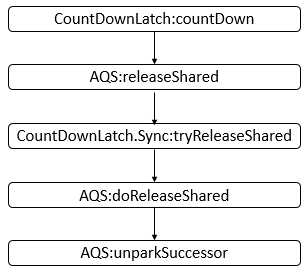
说明:上图给出了可能会调用到的主要方法,并非一定会调用到,之后,会通过一个示例给出详细的分析。
四、示例
下面给出了一个使用CountDownLatch的示例。
package com.hust.grid.leesf.cyclicbarrier; import java.util.concurrent.CountDownLatch; class MyThread extends Thread { private CountDownLatch countDownLatch; public MyThread(String name, CountDownLatch countDownLatch) { super(name); this.countDownLatch = countDownLatch; } public void run() { System.out.println(Thread.currentThread().getName() + " doing something"); try { Thread.sleep(1000); } catch (InterruptedException e) { e.printStackTrace(); } System.out.println(Thread.currentThread().getName() + " finish"); countDownLatch.countDown(); } } public class CountDownLatchDemo { public static void main(String[] args) { CountDownLatch countDownLatch = new CountDownLatch(2); MyThread t1 = new MyThread("t1", countDownLatch); MyThread t2 = new MyThread("t2", countDownLatch); t1.start(); t2.start(); System.out.println("Waiting for t1 thread and t2 thread to finish"); try { countDownLatch.await(); } catch (InterruptedException e) { e.printStackTrace(); } System.out.println(Thread.currentThread().getName() + " continue"); } }
运行结果(某一次):
Waiting for t1 thread and t2 thread to finish t1 doing something t2 doing something t1 finish t2 finish main continue
说明:本程序首先计数器初始化为2。根据结果,可能会存在如下的一种时序图。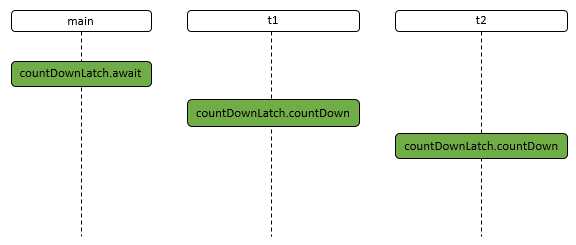
说明:首先main线程会调用await操作,此时main线程会被阻塞,等待被唤醒,之后t1线程执行了countDown操作,最后,t2线程执行了countDown操作,此时main线程就被唤醒了,可以继续运行。下面,进行详细分析。
① main线程执行countDownLatch.await操作,主要调用的函数如下。
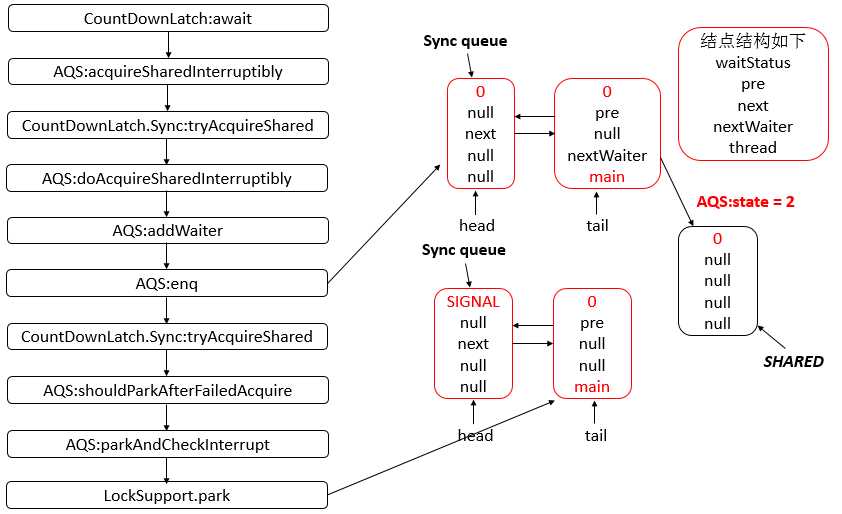 说明:在最后,main线程就被park了,即禁止运行了。此时Sync queue(同步队列)中有两个节点,AQS的state为2,包含main线程的结点的nextWaiter指向SHARED结点。
说明:在最后,main线程就被park了,即禁止运行了。此时Sync queue(同步队列)中有两个节点,AQS的state为2,包含main线程的结点的nextWaiter指向SHARED结点。
② t1线程执行countDownLatch.countDown操作,主要调用的函数如下。
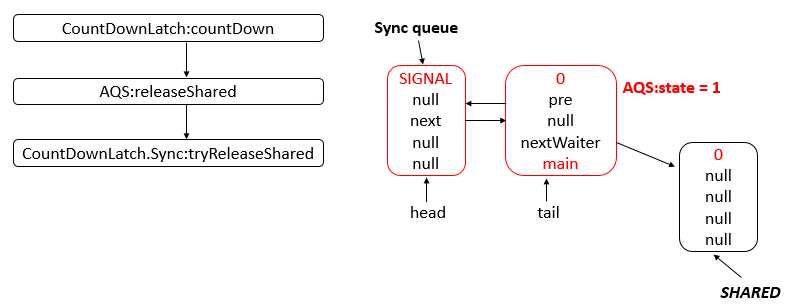 说明:此时,Sync queue队列里的结点个数未发生变化,但是此时,AQS的state已经变为1了。
说明:此时,Sync queue队列里的结点个数未发生变化,但是此时,AQS的state已经变为1了。
③ t2线程执行countDownLatch.countDown操作,主要调用的函数如下。
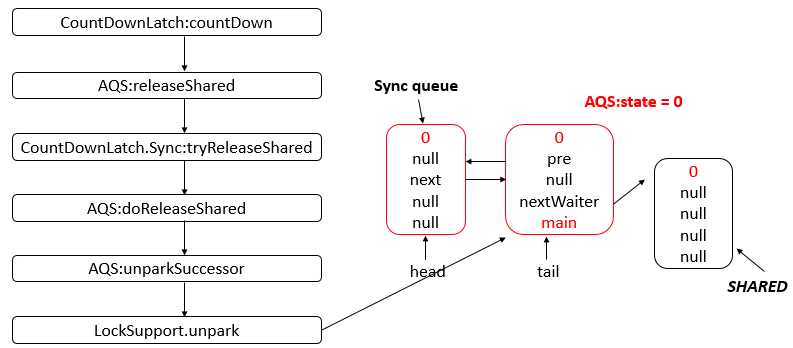 说明:经过调用后,AQS的state为0,并且此时,main线程会被unpark,可以继续运行。当main线程获取cpu资源后,继续运行。
说明:经过调用后,AQS的state为0,并且此时,main线程会被unpark,可以继续运行。当main线程获取cpu资源后,继续运行。
④ main线程获取cpu资源,继续运行,由于main线程是在parkAndCheckInterrupt函数中被禁止的,所以此时,继续在parkAndCheckInterrupt函数运行。
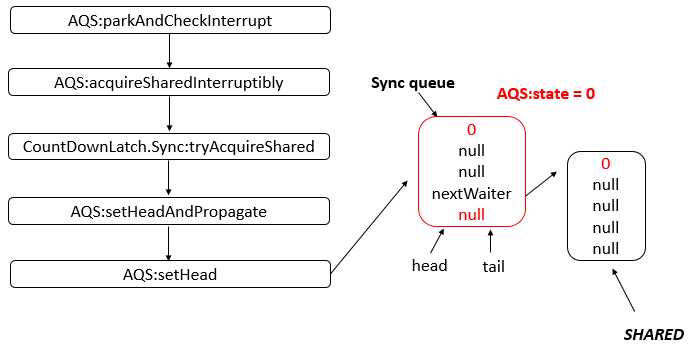
说明:main线程恢复,继续在parkAndCheckInterrupt函数中运行,之后又会回到最终达到的状态为AQS的state为0,并且head与tail指向同一个结点,该节点的额nextWaiter域还是指向SHARED结点。
五、总结
经过分析CountDownLatch的源码可知,其底层结构仍然是AQS,对其线程所封装的结点是采用共享模式,而ReentrantLock是采用独占模式。由于采用的共享模式,所以会导致后面的操作会有所差异,通过阅读源码就会很容易掌握CountDownLatch实现机制。谢谢各位园友的观看~
【JUC】JDK1.8源码分析之CountDownLatch(五)
标签:
原文地址:http://www.cnblogs.com/leesf456/p/5406191.html